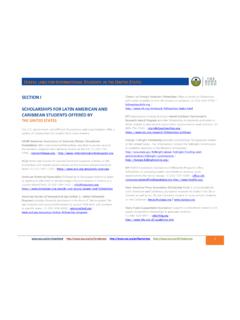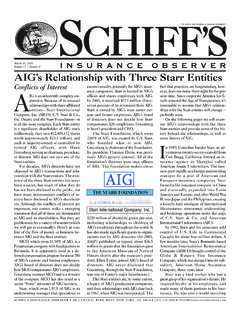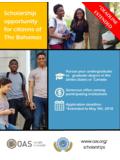Transcription of Higher Education in Latin America - World Bank
1 Higher Educationin Latin America The International DimensionHANS DE WIT, ISABEL CRISTINA JARAMILLO,JOCELYNE GACEL- VILA, JANE KNIGHT,EDITORSDIRECTIONS IN DEVELOPMENTDIRECTIONS IN DEVELOPMENTH igher Education in Latin AmericaHigher Education in Latin AmericaThe International DimensionEditorsHans de Wit, Isabel Christina Jaramillo,Jocelyne Gacel- vila, and Jane Knight 2005 The International Bank for Reconstruction and Development/The World Bank1818 H Street NWWashington DC 20433 Telephone: 202-473-1000 Internet: : rights reserved1 2 3 4 08 07 06 05 The findings, interpretations, and conclusions expressed herein are those of the author(s)and do not necessarily reflect the views of the Executive Directors of the InternationalBank for Reconstruction and Development/The World Bank or the governments World Bank does not guarantee the accuracy of the data included in this boundaries, colors, denominations, and other information shown on any map inthis work do not imply any judgement on the part of The World Bank concerning thelegal status of any territory or the endorsement or acceptance of such and PermissionsThe material in this publication is copyrighted.
2 Copying and/or transmitting portionsor all of this work without permission may be a violation of applicable law. The Inter-national Bank for Reconstruction and Development / The World Bank encourages dis-semination of its work and will normally grant permission to reproduce portions of thework permission to photocopy or reprint any part of this work, please send a requestwith complete information to the Copyright Clearance Center Inc., 222 RosewoodDrive, Danvers, MA01923, USA; telephone: 978-750-8400; fax: 978-750-4470; other queries on rights and licenses, including subsidiary rights, should beaddressed to the Office of the Publisher, The World Bank, 1818 H Street NW, Washington,DC 20433, USA; fax: 202-522-2422; e-mail: 0-8213-6209-7 ISBN 978-0-8213-6209-9eISBN 0-8213-6210-0 DOI: of Congress Cataloging-in-Publication DataHigher Education in Latin America : the international dimension / edited by Hans deWit.
3 [et al.]p. cm. (Directions in development)Includes bibliographical references and , Higher Latin America . and globalization Latin cooperation. I. Wit, Hans de, 1950- II. World Bank. III. Directionsin Development (Washington, ) dc222005048535vContentsForewordPrefaceAc knowledgmentsAbbreviationsAbout the Authors1. An Internationalization Model: Responding to New Realities and ChallengesJane Knight2. Regional and International Challenges to Higher Education in Latin AmericaLauritz B. Holm-Nielsen, Kristian Thorn, Jos Joaqu n Brunner, and Jorge Bal n3. Internationalization of Higher Education in ArgentinaJulio C sar Theiler 4. Internationalization of Higher Education in BrazilSonia Pereira Laus and Marilia Costa Morosini5.
4 Internationalization of Higher Education in ChileCarlos Ram rez Sanchez6. Internationalization of Higher Education in ColombiaIsabel Cristina Jaramillo xixiiixvii xixxxiii 13971 1111491757. Internationalization of Higher Education in CubaRa l Hern ndez P rez8. Internationalization of Higher Education in MexicoJocelyne Gacel- vila 9. Internationalization of Higher Education in PeruLuis Jaime Castillo Butters, Leena Bernuy Quiroga, and Pamela Lastres Dammert10. Key Actors and Programs: Increasing Connectivity in the RegionIsabel Cristina Jaramillo and Jane Knight11. The Latin American Way: Trends, Issues, and DirectionsJocelyne Gacel- vila, Isabel Cristina Jaramillo, Jane Knight, and Hans de WitTables Implications of Globalization for Internationalization of Higher Rationales Driving Institutional-Level Programs and Organizational Strategies for Policies and Programs for Internationalization at the National, Sectoral, and Institutional Components of Internationalization at Home and Approaches to Internationalization at the Institutional Approaches to Internationalization at the National and Sectoral Private Higher Education in Latin America , 1985 Rates of Return to Secondary School and University Education in Selected Latin American Countries.
5 Universities and University Institutes in Argentina, University Enrollment in Argentina, by Type of Institution, 1990and CONEAU Accredited Graduate Courses in Argentina, 1999and Overseas Scholarships Granted to Argentines, 1997 Countries and Regions of Institutions with Which Argentine Public Universities Have Signed Higher Education Institutions in Brazil, by Administrative Type and Academic Organization, 2002 VICONTENTS211239281301341 7 16 23 25 28 30 32 42 59 73 75 76 102 104 Number of Students Enrolled in Face-to-Face Undergraduate Programs in Brazil, by Administrative and Academic Organization, 2002 Number of Students in Master s and Doctorate Programs in Brazil, 1987 2000 Brazilian Scholarships for Study Abroad, by Mode of Study, Brazilian Scholarships Abroad, by Country, CAPES Sponsored Student Exchanges, Joint Research Activities, and Joint Research Projects, by Brazilian and Foreign Cooperation Agreements between Traditional Chilean Universities and Foreign Universities, by Colombian Students Studying Abroad with Scholarships from ICETEX, by Destination, Degree Programs Supported by COLFUTURO, 1992 Distribution of Educational Loans Granted by COLFUTURO, by Field, Number and Type of Institutions of Higher Education in Cuba, 2001 Number of Agreements between Cuban and Foreign Universities and Research Centers, by Country.
6 Number of Joint Research Projects Supported by CONACYT, 1990 Number of Foreign Students in Mexico and Mexican StudentsAbroad Supported by Government Grants, 2001 and Number of Foreign Academics in Mexican Institutions and Mexican Academics Abroad, 2001 and International Agreements Signed by Public and Private Universities in Preferred Destinations of Mexican Students Studying Abroad, 2002 (percent) Measures of International Student Mobility at Public and Private Universities in Mexico Geographical Origin, Marital Status, and Age of Foreign Students in Number of Foreign Students in Mexico During 1998/99 Academic Student Motivations for Supporting Internationalization of Higher Education in Faculty Motivations for Internationalization of Higher Education in Mexico1516 132 133 134 162 185 190 190 215 229 247 248 248 253 254 255 255 255 260 Administrative Staff s Motivation for Favoring Actors and Programs for Internationalization of Higher Key Actors in the Internationalization of Higher Education in Latin Date of Establishment of Organizations and Outward Student Mobility in Latin America .
7 Gross Higher Education Enrollment in Latin America and the OECD, 1965 Total Investment in Higher Education Relative to Income inSelected Countries, Investments in Higher Education in Selected Latin American and Caribbean Countries, 1999 (Percentage of GDP) Cost Recovery at Public Universities in Selected Countries in Latin America and the Annual Number of Students Admitted to and Graduated from Universities in Argentina and Colombia, 1982 Gross Higher Education Enrollment Rate and Expenditure on Higher Education as a Percentage of GDPin Selected Countries, Percentage of Professors with Doctoral Degrees in Selected Countries, Degree to Which University Education Is Perceived to Meet the Needs of a Competitive Distribution of University Students in Selected Countries, byIncome Quintile, Gender Distribution of University Enrollment in Selected Countries, Perception of Knowledge Transfer between Universities and Industry in Selected Countries.
8 Returns to Education in Brazil, by Level of Education , 1982 98 Indicators of National Innovation Systems in Latin Foreign Students at Universities Relative to Proportion Enrolled in Their Region of Origin, 1993 and Emigration by Educated Nationals in Selected Countries in Latin America and the Caribbean, Foreign Students as a Percentage of All Students Enrolled in Host Country, in Selected Countries, Colombian Higher Education Organizational ChartVIIICONTENTS 262 302 334 336 360 40 43 44 45 46 47 49 51 52 54 57 59 60 61 62 64 Number of International Agreements Signed with International Agreements, by Area of Knowledge, Obstacles Holding Back Internationalization of Colombian Distribution of International Cooperation in Cuba, by Activity, Visits by Cuban Academics to Foreign Institutions of Higher Learning, by Country, Visits by Foreign Academics to Cuban Institutions of Higher Learning, by Country, Participation of Cuban Scholars in International Events, by Country, Number of Foreign Scholarship Holders Graduating from Cuban Institutions, Enrollment by Foreign Scholarship Holders in Cuba,1997 2002 Number of Cuban Scholarship Holders Studying Abroad, 1996 Cuban Professors Offering Services Abroad in 2002.
9 By Mexico s National Education Plan 2001 Geographical Distribution of CONACYT Graduate Distribution of CONACYT Scholarship Holders by Knowledge Number of Universities in Peru, 1960 Number of Students Studying in South America ,1993 99 Number of Active Agreements between Peruvian and Foreign UniversitiesIndex 201 202 203 223 224 224 225 226 227 228 231 242 245 246 283 293 294 369xiForewordWhen reading about the lives of those who have made a difference to theirsocieties and their communities, I have always been struck by the impactthey attribute to having studied outside their own countries. Many of usand our colleagues and family members have had the same seems to be a before and after, which has been key in shapingour views of the town, the city, the country, the World , and of those wholive in them an experience that not only brings geographical knowledgebut, more importantly, enriches one s personal mobility of students has been a driver of cultural exchange,knowledge acquisition, and innovation for centuries.
10 Human ingenuitythrives when minds meet across cultures, and new ideas flourish whenyoung people interact with the most accomplished and experiencedscholars and international dimension of Higher Education responds to the chal-lenges of globalization. The interdependence of today s economies andsocieties profoundly affects Higher Education , and Higher Education in turnshapes globalization through teaching, research, and other access to international Higher Education and research sys-tems for talented Latin American students, irrespective of their back-ground or country of origin, is at the heart of strengthening knowledgeand innovation in their countries. An estimated million young studentsworldwide currently study abroad.














